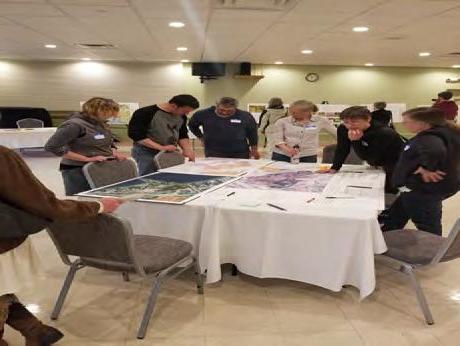
3 minute read
5. Trail Maintenance Guidelines
by BTVParks
Scarification
• Compacted soil will inhibit vegetation from establishing itself and will need to be loosened for the area to be naturalized. The soil should be left loose to allow plants a place to sprout. • The tread surface can be loosened by hand using a pick mattock, McLeoud, fire rake or rouge hoe, or pulaski. Areas where the trail is cupped or recessed should have the edges of the trail knocked down so it will bend into the original landform.
Advertisement
Naturalization
• Naturalization will help accelerate the process of blending the closed trail back into the surrounding landscape. Seeding with local plants and organic material from the surrounding landscape will help reduce the introduction of invasives. • Leaf litter and sections of top soil from the surrounding area should be placed over the loosened soil especially in areas visible from active trails. • Material excavated from new trails or re-routes within the forest can be used to help with the renaturalization of closed trails. The top layer of organic material should be collected and redistributed along closed trail sections. • Planting or transplanting a few native trees or shrubs will also help naturalize the trail and send the message that the corridor is being decommissioned.
To avoid introduction of invasive plant species:
• Using top soil and leaf litter from the surrounding area will minimize the introduction of invasives. • Any imported soil, if required, should be certified to be weed free. • Hand harvest and transplant trees and shrubs from the surrounding forest. • In especially sensitive areas use only leaf litter from the surrounding area and allow for natural regrowth. • Monitor trail closures for invasive plants and eradicate as needed.

5Trail Maintenance Guidelines
TRAIL MAINTENANCE Routine maintenance and assessment of the entire trail network on a seasonal basis will keep trails clean, safe, and maintained at a high standard in both the short and long-term. Maintenance can include everything from removing downed trees to installing new drainage structures or repairing steps and bridges. It also includes the upkeep of trail signage and parking, the removal of trash, and an assessment of trail conditions. This assessment is best kept in a database that also includes a list of short-term and long-term projects and repairs.
• Remove blowdown • Remove hazard trees • Remove leaf litter and weeds in tread
Drainage/Tread
• Clean waterbars, ditches, and dips • Clean culverts
Trail Clean Up
Each spring and fall it is advised to get a volunteer crew out on the trail network to pick up litter. This can be done in conjunction with assessing damage and repair needs for the other maintenance categories.
• Brushing/clearing of overgrown sections • Brush in herd paths/switchback cuts • Remove invasive species
Drainage/Tread
• Replace damaged drainage structures • Repair damaged tread, such as washouts, slumping, spot surfacing • Monitor closed trails for use and invasive species, restore closed area and beef up barrier if needed
Structural Maintenance
• Examine tread, railings, and ramps on all structures
Signage
• Check for missing trail markers or directional signs and replace as needed Trailhead Parking: • Assess drainage and repair where necessary • Ensure trail can adequately be accessed from the trailhead
• Mow and weed a two-foot buffer on each side (on appropriate trails June-September as needed))
Drainage/Tread
• Install new drainage structures where needed
• Knock down outslope berms to maintain drainage • Restore backslope on sidehill trails • Clean up transition areas where two types of surfaces meet • Repair turnpikes and checkdams • Clear hazardous roots, stumps, and rockfall debris
Structural Maintenance
The following should be assessed yearly, and completed as needed: • Repair or replace railings and guardrails • Repair bridges and boardwalks • Replace bridges that exhibit structural damage • Repair cribbing and retaining walls • Repair or replace any steps that exhibit damage • Repair or replace bicycle racks and parking that exhibit damage • Clean any vandalized structures • Repair light fixtures and replace light bulbs in fixtures • Repair or replace gates, fences, and fence posts • Repair or replace shelters that exhibit damage
Signage
• Repair or replace damaged signs and sign posts • Mark or blaze trails where needed • Repair cairns where needed Trailhead Parking: • Repair and update maps and kiosks • Replace missing or damaged signs



